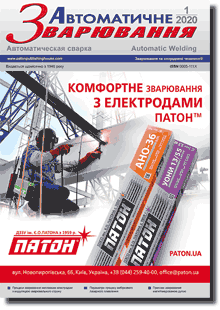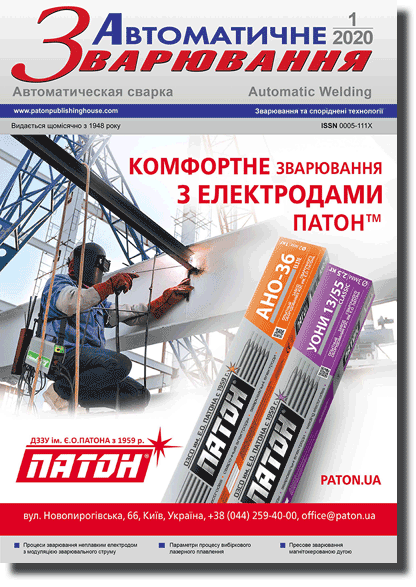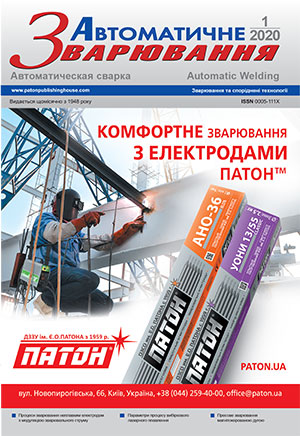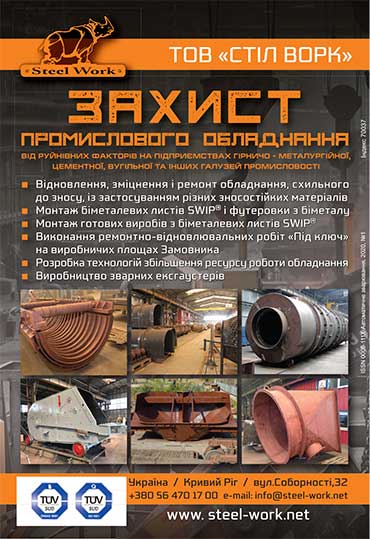| 2020 №01 (04) |
DOI of Article 10.37434/as2020.01.05 |
2020 №01 (06) |

"Avtomatychne Zvaryuvannya" (Automatic Welding), #1, 2020, pp.39-44
Impact of high-frequency peening and moderate climate atmosphere on cyclic fatigue life of tee welded joints with surface fatigue cracks
V.V. Knysh, S.O. Solovej, L.I. Nyrkova, A.O. Grishanov, V.P. Kuzmenko
E.O. Paton Electric Welding Institute of the NAS of Ukraine, 11 Kazymyr Malevych Str., 03150, Kyiv, Ukraine. E-mail: office@paton.kiev.ua
The paper presents the results of investigations of the effectiveness of application of the technology of high-frequency mechanical peening to improve the residual fatigue life of tee welded joints of 15KhSND steel with surface fatigue cracks and corrosion damage characteristic for structures after long-term service under the conditions of moderate climate of the central regions of Ukraine. Corrosion damage on the surface of joints was obtained by exposure in G4 hydrostat at higher temperature and relative humidity of air for 1200 h. It is experimentally established that strengthening by the technology of high-frequency mechanical peening of tee welded joints with surface fatigue cracks of up to 10 mm length and characteristic fatigue damage increases their cyclic fatigue life by up to 10 times. It is shown that application of the technology of high-frequency mechanical peening of welded joints, which contain fatigue cracks of 20 mm and greater length, does not lead to improvement of cyclic fatigue life and is not effective. 10 Ref., Tabl. 2, Fig. 5.
Keywords: tee welded joint, corrosive environment, fatigue, accelerated corrosion testing, high-frequency mechanical peening, improvement of cyclic fatigue life
Received: 06.11.2019
References
1. Kudryavtsev, Y., Kleiman, J., Lugovskoy, A. et al. (2007) Rehabilitation and repair of welded elements and structures by ultrasonic peening. Welding in the Word, 51(7-8), 47-53. https://doi.org/10.1007/BF032665852. Vilhauer, B., Bennett, C.R., Matamoros, A.B., Rolfe, S.T. (2012) Fatigue behavior of welded coverplates treated with ultrasonic impact treatment and bolting. Engineering Structures, 34(1), 163-172. https://doi.org/10.1016/j.engstruct.2011.09.009
3. Abston, S. (2010) The technology and applications of ultrasonic impact technology. Australasian Welding J., 55, 20-21.
4. Kuhlmann, U., Dürr, A., Günther, P. et al. (2005) Verlängerung der lebensdauer von schweißkonstruktion aus höher festen baustählen durch Anwendung der UIT-technologie. Schweißen und Schneiden, 57(8), 384-391.
5. Knysh, V.V., Osadchuk, S.O., Solovei, S.O. et al. (2019) Procedure of accelerated corrosion testing for modeling the long-term effect of moderate climate atmosphere on welded joints. The Paton Welding J., 11, 44-48. https://doi.org/10.15407/tpwj2019.11.08
6. Turnbull, A., Rios, E.R., Tait, R.B. et al. (1998) Improving the fatigue crack resistance of waspaloy by shot peening. Fatigue & Fracture of Engineering Materials & Structures, 21, 1513-1524. https://doi.org/10.1046/j.1460-2695.1998.00125.x
7. Song, P.S., Wen, C.C. (1999) Crack closure and crack growth behavior in shot peened fatigue specimen. Engineering Fracture Mechanics, 63, 295-304. https://doi.org/10.1016/S0013-7944(99)00010-7
8. Branko, C.M., Infante, V., Bartista, R. (2004) Fatigue behavior of the welded joints with cracks, repaired by hammer peening. Fatigue Fract. Engng. Mater. Struct., 27, 785-798. https://doi.org/10.1111/j.1460-2695.2004.00777.x
9. Farrahi, G.H., Majzoobi, G.H., Hosseinzadeh, F., Harati, S.M. (2006) Experimental evaluation of the effect of residual stress field on crack growth behaviour in C(T) specimen. Eng. Fract. Mech., 73, 1772-1782. https://doi.org/10.1016/j.engfracmech.2006.03.004
10. Knysh, V.V., Kuzmenko, A.Z, Solovej, A.S. (2009) Increase of cyclic fatigue life of tee welded joints with surface cracks. The Paton Welding J., 1, 29-33.
Advertising in this issue:
The cost of subscription/purchase order journals or individual articles
| Journal/Currency | Annual Set | 1 issue printed |
1 issue |
one article |
| TPWJ/USD | 384 $ | 32 $ | 26 $ | 13 $ |
| TPWJ/EUR | 348 € | 29 € | 24 € | 12 € |
| TPWJ/UAH | 7200 UAH | 600 UAH | 600 UAH | 280 UAH |
| AS/UAH | 1800 UAH | 300 UAH | 300 UAH | 150 UAH |
| AS/USD | 192 $ | 32 $ | 26 $ | 13 $ |
| AS/EUR | 180 € | 30 € | 25 € | 12 € |
| SEM/UAH | 1200 UAH | 300 UAH | 300 UAH | 150 UAH |
| SEM/USD | 128 $ | 32 $ | 26 $ | 13 $ |
| SEM/EUR | 120 € | 30 € | 25 € | 12 € |
| TDNK/UAH | 1200 UAH | 300 UAH | 300 UAH | 150 UAH |
| TDNK/USD | 128 $ | 32 $ | 26 $ | 13 $ |
| TDNK/EUR | 120 € | 30 € | 25 € | 15 € |
AS = «Automatic Welding» - 6 issues per year;
TPWJ = «PATON WELDING JOURNAL» - 12 issues per year;
SEM = «Electrometallurgy Today» - 4 issues per year;
TDNK = «Technical Diagnostics and Non-Destructive Testing» - 4 issues per year.








